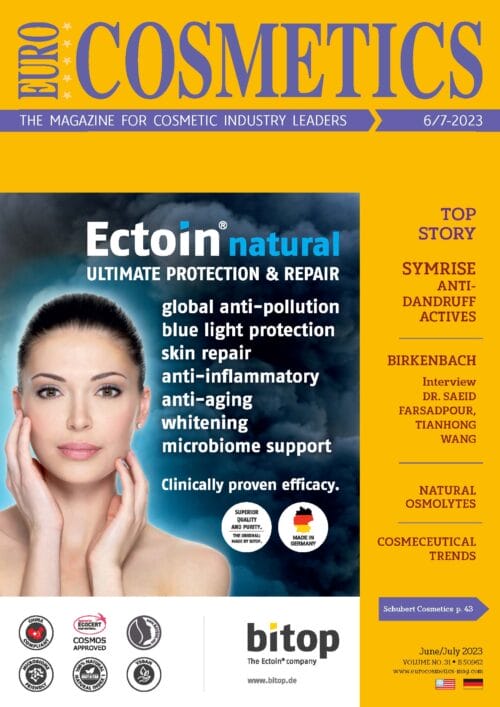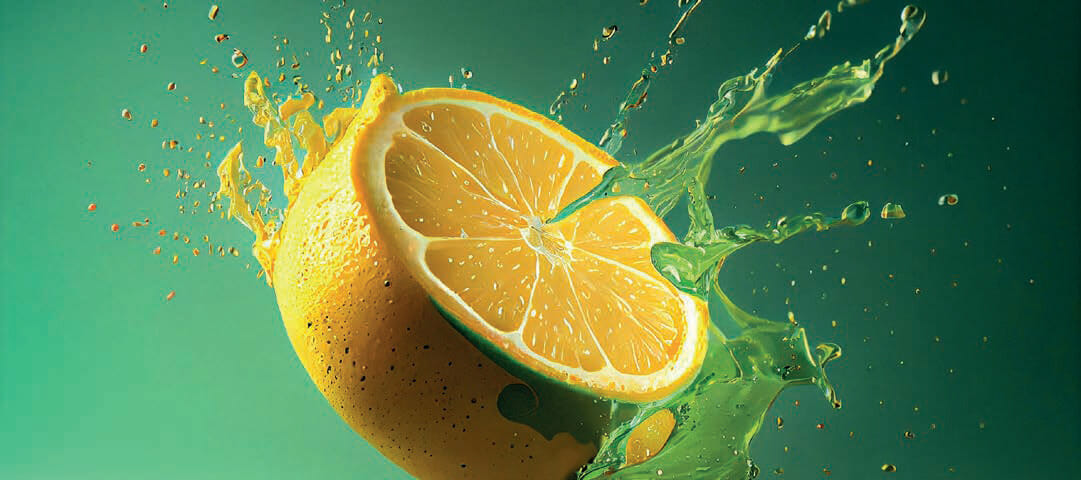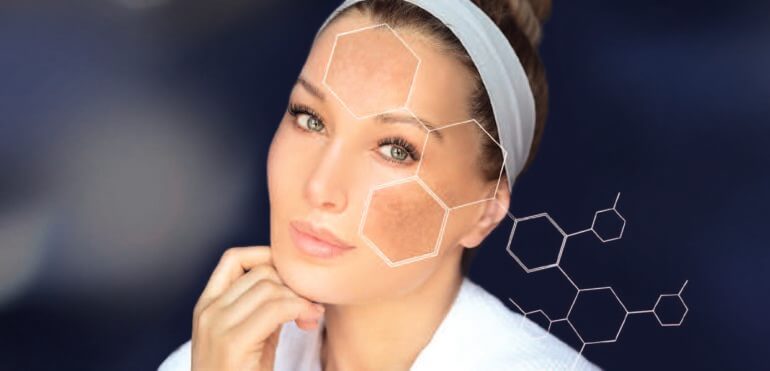
Alpha Hydroxy Acids (AHAs) are organic acids with one or more hydroxyl groups attached directly to the carbon chain at the α-position. AHAs occur naturally in fruits hence popularly known as fruit acids and are also produced synthetically. Most popular AHAs include glycolic (sugarcane), lactic (milk), mandelic (bitter almond), citric (citrus), malic (apple) and tartaric (grape) acids.1 Blends of natural fruit extracts standardized for a certain AHA content or with additional synthetically added AHAs are commonly available for formulation development.
AHAs are polar molecules that disrupt the corneocyte cohesion in the skin barrier. Unlike true keratolytics like urea which act by disaggregation of mature corneocytes in the topmost layer, AHAs act in the lower layer of freshly formed stratum corneum causing it to separate in a sheet-like or “peel” fashion. This results in a thinning effect while making the skin surface cosmetically elegant with improved elasticity.2 First studied for ichthyosis, high concentration AHAs are the most common solution for management of hyperkeratotic skin.
Their application leads to disintegration of corneocyte clusters revealing a normal skin texture within a few days.2,3 The most accepted mechanism of action is reduction of pH by AHAs which interferes with ionic bonds in the cellular junctions and desmosomes leading to desquamation. As an alternate mechanism, calcium chelation by AHAs has been attributed to weakened cellular adhesions.4
Along with exfoliation, AHAs are also known to provide moisturization due to high water retention capacity and increased ceramide production within the stratum corneum, thus enhancing skin barrier function. They have been shown to increase glycosaminoglycans and collagen synthesis and improve the quality of elastic fi bers. Clinical studies with AHAs have shown their benefi ts in reducing hyperpigmentation.3 AHAs have been shown to reduce pigment clumping in the epidermis leading to a more even complexion. Darker skin tones are prone to developing post use infl ammatory hyperpigmentation, and caution is recommended in this population; it may be preferable to use lower strength AHA peels in order to prevent infl ammation. Additionally, citric acid is also known to have antioxidant benefits while lactic acid helps in balancing skin microbiome.2,5,6
Formulating with Fruit Acids
The Cosmetic Ingredient Review Expert Panel, 1998 concluded that glycolic and lactic acid, and their salts were safe for use in cosmetic products at concentrations ≤10%, at fi nal formulation pH ≥3.5. These ingredients were considered safe for use in salon products at concentrations ≤30%, at fi nal formulation pH ≥3.0, in products designed for brief discontinuous use followed by thorough rinsing from the skin, when applied by trained professionals. Directions regarding increased sun sensitivity and use of daily sun protection were mandatory. Revisiting further studies in 2000, the panel recommended glycolic acid to be be used safely at a level of up to 4% and a pH ≥ 3.8 and lactic acid up to a maximum level of 2.5% and a pH ≥ 5 with warnings related to eye irritation and increased UV sensitivity.7
| Ready Reckoner Personal use – NMT 10% AHA pH >3.5 Salon use – NMT 30% Glycolic acid, pH 3.0 Physician strength – 20-70% Glycolic acid H <3.0 |
In a set of studies, US FDA reported that application of AHAs may cause increased UV sensitivity.8 This effect was found to be reversible on stopping the use of AHA-containing products. Under the Fair Labelling and Packaging Act, FDA now requires products with AHAs to contain ingredient declaration. It further recommends a cautionary alert conveying the following information:
Sunburn Alert: This product contains an alpha hydroxy acid (AHA) that may increase your skin’s sensitivity to the sun and particularly the possibility of sunburn. Use sunscreen, wear protective clothing, and limit sun exposure while using this product and for a week afterwards.8
Efficacy of fruit acids in a formulation is a function of concentration and fi nal pH. As a rule, effective AHA products are formulated at the pH which matches the pKa of the acid; this will have approximately 50% of the AHA concentration present as free acid.
Many consumers respond to a glycolic acid peel with mild redness lasting several days. Certain adverse reactions such as peeling, scabbing, infection, recurrence of cold sores, and sensitivity to wind and sun have been reported.9 Formulating technologies are available to help slow the permeation of free acid molecules to reduce irritation potential. Use of amphoteric amino acids such as arginine, lysine, or glycine, as part of the pH adjustment process, helps raise the formulation pH. These materials can also form temporary bonds with the remaining free acid molecules in formulations which leads to a slow-release effect. Studies show that use of amphoteric technology signifi cantly reduces the stinging potential of AHAs, while maintaining an effective pH.5
Use of a combination of fruit acids vs a single acid peel may also minimize side effects without impacting the efficacy of the formulation. Acids such as mandelic acid, are more lipophilic in nature and slow acting, making them suitable for sensitive skin. Impact of the vehicle on AHA efficacy has also been reported. Emulsions have been shown to increase the penetration rate of AHAs compared to aqueous solutions. Use of permeation enhancers, alcohol and glycols may also impact the efficacy of AHA containing products.1,2,5,10
In conclusion, popularity of AHA containing products has moved from the physician’s desk to personal use. Formulators will need to look at new approaches to maximize AHA benefi ts while minimizing the side effects and ensuring effective delivery of the compounds.
References
- Babilas P, Knie U, Abels C. Cosmetic and dermatologic use of alpha hydroxy acids. J Dtsch Dermatol Ges J Ger Soc Dermatol JDDG. 2012 Jul;10(7): 488–91.
- Van Scott EJ, Yu RJ. Hyperkeratinization, corneocyte cohesion, and alpha hydroxy acids. J Am Acad Dermatol. 1984 Nov;11(5 Pt 1):867–79.
- Van Scott EJ, Yu RJ. Control of keratinization with alpha-hydroxy acids and related compounds. I. Topical treatment of ichthyotic disorders. Arch Dermatol. 1974 Oct;110(4):586–90.
- Wang X. A theory for the mechanism of action of the alpha-hydroxy acids applied to the skin. Med Hypotheses. 1999 Nov;53(5):380–2.
- Cosmeceutical Uses and Benefi ts of Alpha, Poly and Bionic Hydroxy Acids – Cosmeceuticals and Cosmetic Practice – Wiley Online Library [Internet]. [cited 2023 Apr 16]. Available from: https://onlinelibrary.wiley.com/doi/abs/10.1002/9781118384824.ch7
- Tang SC, Yang JH. Dual Effects of Alpha-Hydroxy Acids on the Skin. Mol J Synth Chem Nat Prod Chem. 2018 Apr 10;23(4):863.
- Becker LC, Bergfeld WF, Belsito DV, Klaassen CD, Marks JG, Shank RC, et al. Final Report of the Safety Assessment of Hyaluronic Acid, Potassium Hyaluronate, and Sodium Hyaluronate. Int J Toxicol. 2009 Jul 1;28(4_suppl):5–67.
- Center for Food Safety and Applied Nutrition, Office of Cosmetics and Colors. Guidance for Industry: Labeling for Cosmetics Containing Alpha Hydroxy Acids. FDA-2000-P-0063 [Internet]. Available from: https://www.fda.gov/regulatory-information/search-fda-guidance- documents/guidance-industry-labeling-cosmetics-containing-alpha-hydroxy-acids
- Sharad J. Glycolic acid peel therapy – a current review. Clin Cosmet Investig Dermatol. 2013 Nov 11;6:281–8.
- 1Williams RJE. The Use and Safety of Hydroxy Acids in Cosmetics [Internet]. Available from: https://ascc.com.au/the-use-and-safety-of-hydroxy-acids-in-cosmetics/

| Resurfacing Toner | |||
| Phase | INCI | Trade Name | % Addn (w/w) |
| A | Water | Water | 79.6 |
| Propylene Glycol | Propylene Glycol | 5 | |
| Sodium Lactate | Purasal® S/HQ60 1 | 3 | |
| B | Sodium Benzoate | Sodium Benzoate | 0.4 |
| Water | Water | 2 | |
| C | Lactic acid | PURAC® HiPure 90 1 | 10 |
| Manufacturing Process | |||
| Phase A | Mix phase A ingredients. | ||
| Phase B | Mix phase B ingredients in a separate beaker until dissolved. Add this to phase A. | ||
| Phase C | Add Lactic acid to phase A+B+C. Mix well. | ||
| Observations (initial) | |||
| Appearance | Clear transparent water thin liquid | ||
| pH @ 25°C | 4 – 4.5 | ||
| 10% AHA SERUM | |||
| Phase | INCI | Trade Name | % Addn (w/w) |
| A | Water | Water | 77.05 |
| Propylene Glycol | Propylene Glycol | 5 | |
| Pentylene Glycol | Cosphaderm® Pentiol GL 1 | 2 | |
| Xanthan Gum | Keltrol CG-SFT | 0.2 | |
| B | Lactic acid | Purac® UltraPure 2 | 5 |
| Glycolic acid | Glycolic acid 70% solution | 7.85 | |
| C | Sodium Benzoate | Sodium Benzoate | 0.4 |
| Water | Water | 2 | |
| D | Biosaccharide Gum-1 | Fucogel 1.5 P 3 | 0.5 |
| E | Sodium hydroxide | Sodium hydroxide | qs pH |
| Citric acid | Citric acid | qs pH | |
| Manufacturing Process | |||
| Phase A | Disperse Keltrol CG-SFT in Propylene Glycol and add slowly to water. Mix to form a slightly viscous liquid. Add Cosphaderm Pentiol GL and mix. | ||
| Phase B | Mix phase B ingredients one by one ensuring proper mixing before the addition of next ingredient. | ||
| Phase C | Dissolve Sodium Benzoate in water and add to main vessel. Mix well. | ||
| Phase D | Add Biosaccharide Gum-1. | ||
| Phase E | Adjust the pH with sodium hydroxide and citric acid to 3.0 –3.5. | ||
| Observations (initial) | |||
| Appearance | Clear transparent slightly viscous liquid | ||
| pH @ 25°C | 3.0 –3.5 | ||
1. Cosphaderm
2. Corbion
3. Solabia



